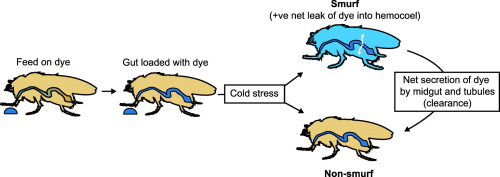Comparative Biochemistry and Physiology A: Molecular & Integrative Physiology ( IF 2.3 ) Pub Date : 2019-10-21 , DOI: 10.1016/j.cbpa.2019.110588 Dawson B H Livingston 1 , Hirva Patel 1 , Andrew Donini 2 , Heath A MacMillan 1

|
Under conditions of stress, many animals suffer from epithelial barrier disruption that can cause molecules to leak down their concentration gradients, potentially causing a loss of organismal homeostasis, further injury or death. Drosophila is a common insect model, used to study barrier disruption related to aging, traumatic injury, or environmental stress. Net leak of a non-toxic dye (Brilliant blue FCF) from the gut lumen to the hemolymph is often used to identify barrier failure under these conditions, but Drosophila are capable of actively transporting structurally-similar compounds. Here, we examined whether cold stress (like other stresses) causes Brilliant blue FCF (BB-FCF) to appear in the hemolymph of flies fed the dye, and if so whether Drosophila are capable of clearing this dye from their body following chilling. Using in situ midgut leak and transport assays as well as Ramsay assays of Malpighian tubule transport, we tested whether these ionoregulatory epithelia can actively transport BB-FCF. In doing so, we found that the Drosophila midgut and Malpighian tubules can mobilize BB-FCF via an active transcellular pathway, suggesting that elevated concentrations of the dye in the hemolymph may occur from increased paracellular permeability, reduced transcellular clearance, or both.
Summary statement
Drosophila are able to actively secrete Brilliant blue FCF, a commonly used marker of barrier dysfunction.
中文翻译:

明亮的蓝色FCF通过果蝇中肠和Malpighian小管上皮细胞的主动转运。
在压力条件下,许多动物遭受上皮屏障破坏,破坏上皮屏障会导致分子泄漏其浓度梯度,从而可能导致机体稳态丧失,进一步的伤害或死亡。果蝇是一种常见的昆虫模型,用于研究与衰老,外伤或环境压力有关的屏障破坏。在这种情况下,通常使用无毒染料(亮蓝FCF)从肠腔到血淋巴的净泄漏来确定屏障破坏,但是果蝇能够主动转运结构相似的化合物。在这里,我们检查了冷应激(像其他应激一样)是否导致艳蓝FCF(BB-FCF)出现在饲喂该染料的果蝇的血淋巴中,如果是,则果蝇能够在冷却后从体内清除这种染料。使用原位中肠渗漏和转运测定以及Malpighian肾小管转运的Ramsay测定,我们测试了这些离子调节性上皮是否可以主动转运BB-FCF。通过这样做,我们发现果蝇中肠和马氏小管可以通过活跃的跨细胞途径动员BB-FCF,这表明血淋巴中染料的浓度升高可能是由于细胞旁通透性增加,跨细胞清除率降低或两者兼而有之。
摘要声明
果蝇能够主动分泌亮蓝FCF,这是屏障功能障碍的常用标记。



























 京公网安备 11010802027423号
京公网安备 11010802027423号